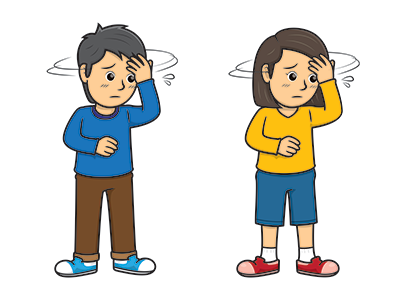Fainting (also known as syncope) is common, particularly in teenagers. This brief loss of consciousness goes by multiple names: Vasovagal, neurocardiogenic, reflex mediated, vasodepressor and orthostatic syncope. Though it can be a frightening event, the common faint lasts just seconds and is typically not a sign of a dangerous problem. A bigger concern is avoiding injury during the fall. Less often, a faint can be a warning sign of a life-threatening condition. Knowing the difference between a potentially dangerous faint and the more common, benign faint may seem intimidating, but there are clues that can help guide a family or provider to seek additional help and evaluation.
Causes of fainting
The cause of syncope often may be found in the story: The circumstances in which it occurs, and the signs and symptoms felt by the individual prior to the event. Benign (or nonthreatening) fainting occurs in classic settings, including:
- Standing for a long time
- Warm environments
- Sudden changes in position
- Dehydration
- Uncomfortable circumstances, such as needle exposures or the sight of blood
There are other, less classic but equally innocent triggers for fainting, including:
- Urination
- Hair brushing
- After finishing intense exercise
Fainting symptoms
Most people feel the faint coming. Symptoms before a benign faint may include dizziness or lightheadedness, feeling hot or clammy, sweating, nausea, appearing pale, feeling palpitations, and having dimming or blurring of vision. An innocent faint may be accompanied by brief seizure activity. After the faint, many people feel tired or nauseated, but they are alert and aware of their surroundings. Drinking plenty of water every day can help prevent a common faint.
Atypical fainting
An atypical faint that may be related to a heart condition more often occurs without warning or may occur during exercise. The potentially dangerous diagnoses that can cause an atypical faint include very fast and irregular heart rhythm problems (arrhythmias) and heart conditions that prevent adequate pumping of blood. Arrhythmia syndromes that can lead to a dangerous ventricular arrhythmia include Wolff-Parkinson-White (WPW) and inherited heart rhythm disorders, such as long QT syndrome. Structural or functional heart disease with potential for a dangerous faint includes cardiomyopathies (hypertrophic, dilated, arrhythmogenic and noncompaction), congenital heart disease with obstruction to aortic or coronary blood flow and pulmonary hypertension.
Fainting may be the first indication of a more serious problem. Evaluation and diagnosis are important to ensure life-saving treatment. Patients should be evaluated immediately and referred to a cardiologist if they experience:
- Fainting without an obvious trigger or in a non-typical setting
- Fainting without any warning signs or symptoms
- Fainting associated with exercise or stress, particularly occurring during exertion
- History of almost drowning or receiving cardiopulmonary resuscitation (CPR)
- Abnormal cardiovascular physical examination or electrocardiogram (EKG or ECG)
- Known or discovered WPW pattern
- Family history of suspicious syncope, seizures or arrhythmias
- Family history of premature cardiac disease or sudden unexplained death before 50 years of age.
 https://riseandshine.childrensnational.org/wp-content/uploads/2023/01/group-of-young-athletes-huddling-feature.png
300
400
Rise and Shine
https://riseandshine.childrensnational.org/wp-content/uploads/2017/11/childrens_riseandshine_logo.jpg
Rise and Shine2025-09-09 07:00:362025-09-09 13:28:37Sudden cardiac arrest in children: What parents need to know
https://riseandshine.childrensnational.org/wp-content/uploads/2023/01/group-of-young-athletes-huddling-feature.png
300
400
Rise and Shine
https://riseandshine.childrensnational.org/wp-content/uploads/2017/11/childrens_riseandshine_logo.jpg
Rise and Shine2025-09-09 07:00:362025-09-09 13:28:37Sudden cardiac arrest in children: What parents need to know





















Leave a Comment
Want to join the discussion?Feel free to contribute!